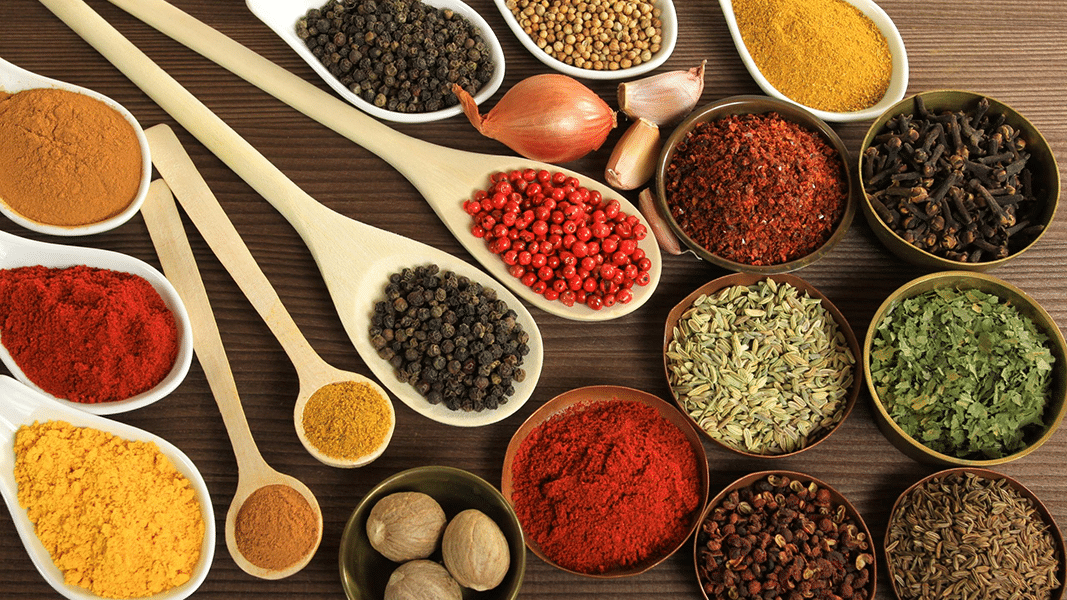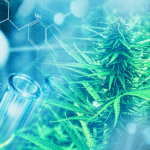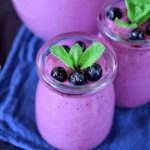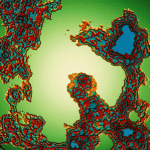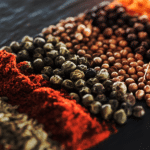Modern science is starting to catch on to the wisdom of our ancestors, who knew a lot about using aromatic herbs and spices for medicinal purposes. The use of spices for cooking, healing and dyeing fabric has shaped much of human history. In ancient times these highly precious commodities were traded along well-traveled spice routes throughout Asia, the Middle East, Northern Africa and Europe. Some spices were literally worth their weight in gold.
Yet it’s only recently that scientists have discovered the bioactive constituents and molecular mechanisms of several common kitchen spices, which have been shown to reduce oxidative stress and inflammation while modulating multiple healing pathways simultaneously. A number of scientific studies confirm that the health-promoting properties of various spices are mediated by the same receptors in the human brain and body that respond pharmacologically to cannabis.
Saffron: Nerve Tonic
A 2013 report by Iranian scientists in Pharmacognosy Review examined the neuroprotective effects of saffron extracts, which inhibited the build-up of beta-amyloid plaque in the brain in animal models of Alzheimer’s. The same article noted that saffron extracts could “prevent retinal damage [and] age-related macular degeneration.” An Australian research team previously showed that saffron can counteract the effects of continuous bright light exposure in lab rats by enhancing retinal blood flow. Saffron “engages” both the CB1 cannabinoid receptor and the CB2 cannabinoid receptor “in order to afford retinal protection,” the Australian scientists concluded.
Described as the most expensive cultivated herb in the world, saffron (Crocus sativus) is a much-revered food seasoning and a natural colorant. Cultivated originally in Persia and Asia Minor, this legendary spice comes from a light purple flower with thread-like red-orange stigma that contains 150 bioactive components, including carotenoids, flavonoids, and other potent polyphenols. A rich source of riboflavin (vitamin B-2) and free-radical scavengers, saffron has a long history of use as a folk medicine for treating cancer, convulsions, headaches, skin conditions, asthma, ulcers, premenstrual distress, and other diseases. The Ebers papyrus (1550 BC) refers to saffron as a “cheering cardiac medicament” and a cure for kidney problems.
Scientific studies indicate that saffron improves learning and memory by inhibiting the breakdown of acetylcholine. Saffron also enhances the functioning of the GABA receptor, which explains in part its efficacy as relaxant and nerve tonic. Clinical trials evaluated the anti-depressant properties of saffron and concluded that it was more effective than a placebo and equivalent to Prozac.
Turmeric: Holy Powder
Turmeric (Curcuma longa), a perennial plant of the ginger family, has a safe 6,000-year track record as a medicinal herb, a culinary spice, and a dye for fabric and food. The fleshy rhizome of this all-star botanical is ground into a deep orange-yellow powder and used to season South Asian cuisine. It is a significant ingredient in most commercial curries, as well as a staple of Ayurvedic medical practice, which utilizes turmeric (typically in combination with other herbs) to treat indigestion, throat infections, metabolic dysfunction, common colds, and many other ailments. Known as the holy powder of India, turmeric is also applied topically as an antibacterial and antifungal remedy for skin sores and to clean wounds.
The Food and Drug Administration, the perennial handmaiden of Big Pharma, recognizes turmeric as a food-coloring agent but not as a therapeutic substance, despite more than 5600 peer-reviewed studies of turmeric and its main polyphenolic component, curcumin, that document numerous healing attributes. There is more evidence-based scientific literature (1500 science articles) supporting the use of curcumin against cancer than any other nutrient, including vitamin D.
Much like saffron, curcumin is a potent antioxidant that confers neuroprotective effects through multiple molecular channels. Turmeric protects against alcohol-induced brain damage, improves insulin sensitivity and cardiovascular function, inhibits platelet aggregation, and facilitates the clearing of beta-amyloid plaque associated with Alzheimer’s dementia. It’s worth noting that the incidence of Alzheimer’s and other neurodegenerative diseases among people living in the Asian subcontinent, where turmeric is ubiquitous, is significantly lower than in North America.
Turmeric’s versatility as a medicinal herb derives in part from its interaction with the endocannabinoid system, which regulates numerous physiological processes. In May 2012, Neurochemical Research identified the CB1 cannabinoid receptor as a mediator of curcumin’s antidepressant effect: “treatment with curcumin,” the report notes, “results in the sustained elevation…of endocannabinoids.” In December 2013, the European Journal of Pharmacology disclosed that curcumin reduces liver fibrosis by modulating cannabinoid receptor transmission.
Peppercorn: Black Gold
Employed since antiquity as both a food seasoning and a folk cure, black pepper (Piper nigrum) is the world’s most traded spice. Touted as “black gold,” the dried fruit of this woody vine — the peppercorn — was considered such a valuable commodity that it served as a substitute for money in business transactions. During the Middle Ages in Europe, black pepper was a luxury item only the wealthy could afford. Today, it is one of most commonly used spices on the planet.
The manifold therapeutic properties of black pepper have been validated by modern science. The essential oil of black pepper reduces nicotine cravings and eases withdrawal symptoms. An anti-spasmodic and anti-convulsant, it can also lower blood pressure and relieve digestive distress. Piperine, black pepper’s principal bioactive constituent, has been shown to inhibit cancer cell proliferation in animal models of osteosarcoma. This black pepper alkaloid also potentiates the antitumoral and apoptotic effects of turmeric by enhancing the bioavailability of curcumin. When co-administered, piperine and curcumin interact synergistically to confer a stronger antidepressant effect than either compound delivers on its own.
In addition to piperine, black pepper contains vitamin K, iron and manganese along with a robust array of aromatic terpenes, which should be familiar to cannabis connoisseurs: pinene, limonene, linalool, sabinene…. Black pepper is particularly well endowed with the sesquiterpene beta-caryophyllene, an important medicinal component of many cannabis strains. Beta-caryophyllene is the only terpene known to bind directly to CB2, the cannabinoid receptor that regulates immune function, the peripheral nervous system, metabolic tissue activity, and other physiological processes.
Black pepper’s potent anti-inflammatory juju is mediated by the CB2 receptor. THC also binds directly to the CB2 receptor, although this is not what makes a person feel high when he or she consumes cannabis. That’s because CB2 receptors are not present to a significant degree in the brain and central nervous system.
Beta-caryophyllene is a significant component of several other common kitchen spices, including clove, cinnamon and oregano.
Nutmeg: Cannabinoid Booster
Nutmeg (the dried kernel of Myristica fragrans) does not directly activate the CB1 cannabinoid receptor in the brain or the CB2 cannabinoid receptor in immune cells. But this commonly used kitchen spice can have a powerful impact on the endocannabinoid system.
A 2016 study in Pharmaceutical Biology reported that nutmeg interacts with the endocannabinoid system by inhibiting certain key enzymes that catabolize (break down) the two main endocannabinoids, anandamide and 2AG. Likened to the brain’s own marijuana, these short-lived endogenous cannabinoid compounds bind to the CB1 and CB2 receptors. This triggers a signaling cascade on a cellular level that protects neurons against toxic insults (stress) and promotes neurogenesis (the creation of new stem cells in adult mammals).
Two catabolic enzymes, fatty acid amide hydrolase (FAAH) and monoglycerol lipase (MAGL), are involved in the breakdown of anandamide and 2AG, respectively. Simply put, less FAAH and MAGL means more anandamide and 2AG. So by inhibiting these catabolic enzymes, nutmeg raises the level of anandamide and 2AG in the brain and boosts cannabinoid receptor signaling throughout the body. FAAH and MAGL inhibition has proven to be beneficial for easing pain, anxiety, hypertension and various inflammatory conditions in preclinical research, which lends credence to traditional medical uses of nutmeg.
Ayurvedic healers in India utilize nutmeg as an anxiolytic or anxiety-reducing agent. But there are conflicting accounts of nutmeg’s effect on anxiety and depression— higher doses cause a biphasic response, exacerbating mood disorders and triggering hallucinations. Nutmeg has long been known for its central nervous system activity. In an article in Nature (1966), Alexander Shulgin identified “myristicin as a psychotropic substance.”
Many prison inmates, including Malcolm X before his conversion to Islam, have sniffed and swallowed nutmeg to get high. Now we know how and why nutmeg has a psychoactive effect — it stimulates cannabinoid receptor transmission by suppressing the enzymes that break down the brain’s own marijuana.
Ecological Medicine
Herbs and spices are ecological medicines. Seventy-five to ninety percent of the world’s rural people still rely on traditional plant medicine as their primary mode of health care. Numerous plants — not just cannabis — are endowed with compounds that interact directly or indirectly with the endocannabinoid system. The health benefits of many common kitchen spices are mediated by the same cannabinoid receptors in the human brain and body that marijuana activates.
Scientific research into marijuana’s effects on the brain has opened the door to whole new vistas of understanding human biology and physiology. As we welcome cannabis back into the pantheon of approved medicinal herbs, perhaps we should rethink our ideas about the endocannabinoid system, so named after the plant that led to its discovery, and stretch its boundaries to encompass an abundance of botanicals.
Martin A. Lee is the director of Project CBD. He’s authored and edited several books, including Smoke Signals, Acid Dreams, and The Essential Guide to CBD. © Copyright, Project CBD. May not be reprinted without permission.
Sources
- Akhonzadeh S, et al, “Saffron in the treatment of patients with mild to moderate Alzheimer’s disease,” J Clini Parm Ther, 2010 Oct.
- Bhutani, MK, et al, “Anti-depressant effect of curcumin and its combination with piperine in unpredictable chronic stress-induced behavioral, biochemical and neurochemical changes,” Pharmocol Biochem Behav, 2009 March.
- Cordell, Barbara and Buckle, Jane, “The effects of aromatherapy on nicotine craving on a U.S. campus: a small comparison study.” J Altern Complement Med. 2013 July 31.
- El-Alfy, Abir T, et al, “Indirect modulation of the endocannabinoid system by specific fractions of nutmeg total extract,” Pharmaceutical Biology, 2016.
- Gertsch, J, et al, “Beta-caryophyllene is a dietary cannabinoid,” Proc Natl Acad Sci USA, 2008 July.
- Gohari, Ahmad Reza, et al, “An overview on saffron, phytochemicals, and medicinal properties,” Pharmacogn Rev, 2013 Jan-Jun.
- Hassan M, et al, “Pharmacological basis for the medicinal use of black pepper and piperine in gastrointestinal disorders,” Anticancer Res. 2009 Dec 01.
- Hassanzadeh P, et al, “The CB1 receptor-mediated endocannabinoid signaling and NGF: the novel targets of curcumin,” Neurochemical Research, 2012 May.
- Javadi, B, et al, “A Survey of Saffron in Major Islamic Traditional Medicine Books,” Iranian Journal of Basic Medical Sciences, 2013.
- Ji, Sayer, “600 Reasons Turmeric May Be the World’s Most Important Herb,” GreenMedInfo.com, July 10, 2013.
- Ji, Sayer, “Better than Chemo: Turmeric Kills Cancer Not Patients,” GreenMedInfo.com, Sept. 12, 2015.
- Kannappan, Ramaswamy, et al, “Neuroprotection by Spice-Derived Nutraceuticals,” Molecular Neurobiology, 2011 October.
- Kazem M, et al, “Antispasmodic effect of Piper nigrum fruit hot water extract on rat ileum,” Pak J Biol Sci, 2008 Jun 01.
- Khazdair, Mohammad Reza, et al, “The effects of Crocus sativus (saffron) and its constituents on nervous system: A review,” Avicenna Journal of Phytomedicine, Sept-Oct 2015.
- Khorasany, AR, et al, “Therapeutic effects of saffron (Crocus sativus L.) in digestive disorders: a review,” Iranian Journal of Basic Medical Sciences, 2016.
- Mishra A, et al, “Anticonvulsant mechanisms of piperine, a piperidine alkaloid,” Channels (Austin). 2015 Sep 02.
- Natoli, R, et al, “Gene and noncoding RNA regulation underlying photoreceptor protection: microarray study of dietary antioxidant saffron and photobiomodulation in rat retina,” Molecular Vision, 2016.
- Patil, Vaishali M, et al, “Quantum Chemical and Docking Insights Into Bioavailability Enhancement of Curcumin by Piperine in Pepper,” J Phys Chem A, 2016 May 26.
- Rapino, Cinzia, et al, “Type-1 and Type-2 Cannabinoid Receptor Signaling is Involved in the Neuroprotective Effect of Saffron of Rat Retina,” poster at International Cannabinoid Research Society conference, 2016 June.
- Rose, J E and Behm FM, “Inhalation of vapor from black pepper extract reduces smoking withdrawal symptoms,” Drug Alcohol Depend. 1994 Feb 01.
- Samarghandian, Saeed, et al, “Anticarcinogenic effect of saffron (crocus sativus L.) and its ingredients,” Pharmacognosy Res, 2014 Apr-Jun.
- Zhang J, et al, “Piperine inhibits proliferation of human osteosarcoma cells via G2/M phase arrest and metastasis by suppressing MMP-2/-9 expression,” Int Immunopharmacol. 2014 Dec 31.
- Zhang Z, et al, “Curcumin modulates cannabinoid receptors in liver fibrosis in vivo and inhibits extracellular matrix expression in hepatic stellate cells by suppressing cannabinoid receptor type-1 in vitro,” European Journal of Pharmacology, 2013 Dec 5.

